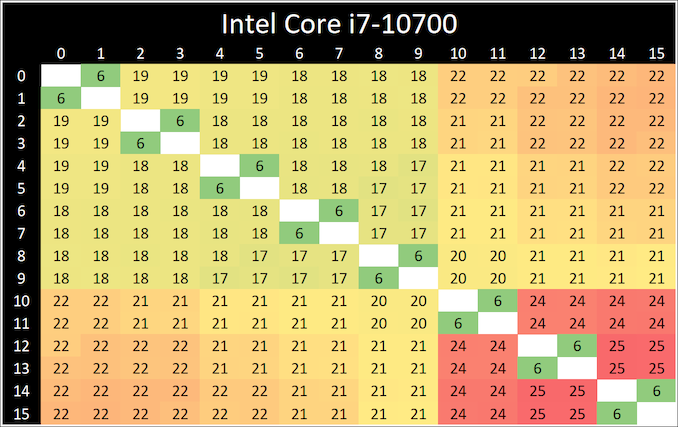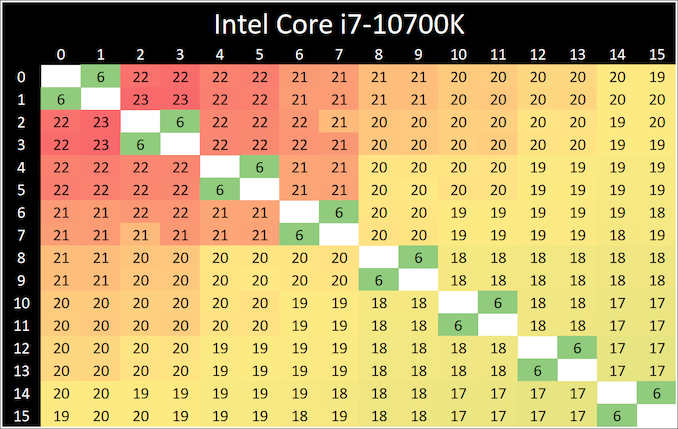Intel Core i7-10700 vs Core i7-10700K Review: Is 65W Comet Lake an Option?
by Dr. Ian Cutress on January 21, 2021 10:30 AM EST- Posted in
- CPUs
- Intel
- Core i7
- Z490
- 10th Gen Core
- Comet Lake
- i7-10700K
- i7-10700
CPU Tests: Microbenchmarks
Core-to-Core Latency
As the core count of modern CPUs is growing, we are reaching a time when the time to access each core from a different core is no longer a constant. Even before the advent of heterogeneous SoC designs, processors built on large rings or meshes can have different latencies to access the nearest core compared to the furthest core. This rings true especially in multi-socket server environments.
But modern CPUs, even desktop and consumer CPUs, can have variable access latency to get to another core. For example, in the first generation Threadripper CPUs, we had four chips on the package, each with 8 threads, and each with a different core-to-core latency depending on if it was on-die or off-die. This gets more complex with products like Lakefield, which has two different communication buses depending on which core is talking to which.
If you are a regular reader of AnandTech’s CPU reviews, you will recognize our Core-to-Core latency test. It’s a great way to show exactly how groups of cores are laid out on the silicon. This is a custom in-house test built by Andrei, and we know there are competing tests out there, but we feel ours is the most accurate to how quick an access between two cores can happen.
When we first reviewed the 10-core Comet Lake processors, we noticed that a core (or two) seemed to take slightly longer to ping/pong than the others. These two parts are both derived from the 10-core silicon but with two cores disabled, and we still see a pattern of some cores having additional latency. The ring on the 8-core parts still acts like a 10-core ring, but it all depends on which cores were disabled.
Frequency Ramping
Both AMD and Intel over the past few years have introduced features to their processors that speed up the time from when a CPU moves from idle into a high powered state. The effect of this means that users can get peak performance quicker, but the biggest knock-on effect for this is with battery life in mobile devices, especially if a system can turbo up quick and turbo down quick, ensuring that it stays in the lowest and most efficient power state for as long as possible.
Intel’s technology is called SpeedShift, although SpeedShift was not enabled until Skylake.
One of the issues though with this technology is that sometimes the adjustments in frequency can be so fast, software cannot detect them. If the frequency is changing on the order of microseconds, but your software is only probing frequency in milliseconds (or seconds), then quick changes will be missed. Not only that, as an observer probing the frequency, you could be affecting the actual turbo performance. When the CPU is changing frequency, it essentially has to pause all compute while it aligns the frequency rate of the whole core.
We wrote an extensive review analysis piece on this, called ‘Reaching for Turbo: Aligning Perception with AMD’s Frequency Metrics’, due to an issue where users were not observing the peak turbo speeds for AMD’s processors.
We got around the issue by making the frequency probing the workload causing the turbo. The software is able to detect frequency adjustments on a microsecond scale, so we can see how well a system can get to those boost frequencies. Our Frequency Ramp tool has already been in use in a number of reviews.
Both processors ramp from idle to full turbo in about six milliseconds, well within a single frame of standard gaming.













210 Comments
View All Comments
vegemeister - Friday, January 22, 2021 - link
CPU will not shutdown. It will only throttle. As it is designed to do. As every laptop CPU does.And performance will be much better than 65/200, because power vs. frequency grows much faster than linear, and very few workloads run anywhere near max power anyway.
I like making fun of Intel's poor efficiency as much as the next guy, but this is much ado about nothing.
eastcoast_pete - Saturday, January 23, 2021 - link
I actually meant throttling; the point is that keeping the heat budget to the one stated will show just how fast a CPU can go if it's not allowed to pull way above its stated power envelope. Giving a CPU and MoBo a fancy cooling solution that can dissipate over 3x the rated power invites "cheating". To use an automotive analogy: the rated horsepower of a gasoline engine is for commercially available gas with all the required accessories connected, not with open headers, disconnected pumps and boosted with nitrous.watzupken - Thursday, January 21, 2021 - link
That's why I steer clear from Intel chips nowadays. The TDP and actual power consumption are worlds apart. While people can argue that TDP = base clockspeed. That is true. But when Intel is advertising that their CPU can beat competition, in order to achieve this feat, they failed to mentioned that it actually takes 200W or more, and not the advertised TDP. If I were AMD, I will use power metrics to put Intel to shame in my marketing material. The same sort of power consumption will likely stick with Rocket Lake.Spunjji - Friday, January 22, 2021 - link
It's actually likely to get slightly worse - larger, more complex cores running at similar clock speeds on the same lithography. We're likely to see as high as 65W+ for single core loads under turbo, and could get as high as 250W for all 8 on the 11900K.scineram - Monday, January 25, 2021 - link
No, we will not.Spunjji - Monday, January 25, 2021 - link
Is this saying you don't think Rocket Lake will hit those power requirements, or that you won't buy it? 😁zodiacfml - Thursday, January 21, 2021 - link
long story short, Intel just placed 65W there without regard to anything except they want this chip to squarely compete with the 5600x. Amazing to find Intel in this position vs AMD. I don't remember AMD being this bad in the past while 2 generations of process nodes behind Intel which I recall AMD offers slightly less performance but around twice the power of a competing Intel CPU.Dug - Friday, January 22, 2021 - link
"There is a large number of the tech audience that complain when DDR4-2933 memory is used"No kidding? You mostly run 2100, and can't be bothered with testing anything beyond, because of warranty? Maybe you should just review Dell and HP systems. The long video you linked, basically explains nothing but opinion. Why do you even bother with a K processor or a Z motherboard? You are no longer an enthusiast site, and have made this place into a tweeting disaster that can't be bothered with any recent video card. A PHD may make you knowledgeable about a subject, but obviously not about your audience, who are the one's that pay your salary.
Shmee - Friday, January 22, 2021 - link
I kinda agree here actually, while I understand the argument for only testing at JEDEC specs, I would like to see tests at decent XMP speeds as well, at the very least, if one is not going to further tweak the RAM. Overclocking is more common I suspect these days, if one is an enthusiast. For a lot of chips, it is a huge waste not to OC.I would agree as well that more recent GPUs should be invested in/obtained for reviews, though understandably this is not a great time to find them. On the plus side, kudos for using the MSI Meg Godlike, that is one heck of a board. I have the Ace myself.
Oxford Guy - Sunday, January 24, 2021 - link
I don't think it's particularly credible to consider XMP overclocking in the same way manual overclocking is seen.1. It comes from the vendor, guaranteed to run at those settings.
2. Motherboard makers post lists of RAM, at XMP speeds, for people to pick so they can have something that works.
3. Overclocking is putting 215W sustained into a 65W chip. Ask Intel and its motherboard maker friends about that.